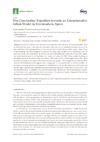Identificador persistente para citar o vincular este elemento:
https://accedacris.ulpgc.es/jspui/handle/10553/114461
| Campo DC | Valor | idioma |
|---|---|---|
| dc.contributor.author | Jiménez Barrado, Victor | en_US |
| dc.contributor.author | Campesino Fernández, Antonio-José | en_US |
| dc.date.accessioned | 2022-04-27T16:37:14Z | - |
| dc.date.available | 2022-04-27T16:37:14Z | - |
| dc.date.issued | 2018 | en_US |
| dc.identifier.issn | 2413-8851 | en_US |
| dc.identifier.uri | https://accedacris.ulpgc.es/handle/10553/114461 | - |
| dc.description.abstract | Given the incessant and clandestine proliferation of housing on the Undevelopable Land of Extremadura, Spain, and that administrative attention to this problem has been scarce, it is inevitable that urban geographers will turn away from the main focus of their study: cities. Thus, a methodology has been designed to discover housing irregularities in the countryside, and to quantify, locate, and date them. To do this, we have digitalized all urban planning in the region and performed sweeps on orthophotos at a maximum scale of 1:1500. Every single dwelling in the region has been detected using this method. The rurbanization in this region means that there has been a change in the urban model that has not been gradual. The fragile and weakened urban network of Extremadura has agglutinated a large part of the population, which has resulted in territorial emptying, but not in a stagnation of artificialization. In fact, the urban network has become increasingly dispersed and isolated because of residential growth outside the limits of Urban and Developable Land. In addition, this growth is eminently clandestine. The worrying results show us that there is an urgent need for the Administration to create and apply a Regional Plan for the Management and Control of Rurban Development. | en_US |
| dc.language | spa | en_US |
| dc.relation.ispartof | Urban science | en_US |
| dc.source | Urban Science [2413-8851], 2018, 2, 103 | en_US |
| dc.subject | 332904 Uso del suelo | en_US |
| dc.subject | 540401 Geografía urbana | en_US |
| dc.subject.other | Illegal urbanization | en_US |
| dc.subject.other | Counter-urbanization | en_US |
| dc.subject.other | Extremadura | en_US |
| dc.subject.other | Urban expansion | en_US |
| dc.subject.other | Periurbanization | en_US |
| dc.subject.other | Rurbanization | en_US |
| dc.subject.other | Suburbanization | en_US |
| dc.title | The Clandestine Transition towards an Unsustainable Urban Model in Extremadura, Spain | en_US |
| dc.type | info:eu-repo/semantics/article | en_US |
| dc.type | Article | en_US |
| dc.identifier.doi | 10.3390/urbansci2040103 | en_US |
| dc.investigacion | Artes y Humanidades | en_US |
| dc.type2 | Artículo | en_US |
| dc.utils.revision | Sí | en_US |
| dc.identifier.ulpgc | No | en_US |
| dc.contributor.buulpgc | BU-HUM | en_US |
| item.fulltext | Con texto completo | - |
| item.grantfulltext | open | - |
| crisitem.author.dept | GIR IATEXT: Sociedades y Espacios Atlánticos | - |
| crisitem.author.dept | IU de Análisis y Aplicaciones Textuales | - |
| crisitem.author.dept | Departamento de Geografía | - |
| crisitem.author.orcid | 0000-0001-7064-7465 | - |
| crisitem.author.parentorg | IU de Análisis y Aplicaciones Textuales | - |
| crisitem.author.fullName | Jiménez Barrado, Victor | - |
| Colección: | Artículos | |
Citas de WEB OF SCIENCETM
Citations
3
actualizado el 18-ene-2026
Visitas
39
actualizado el 10-ene-2026
Descargas
1
actualizado el 10-ene-2026
Google ScholarTM
Verifica
Altmetric
Comparte
Exporta metadatos
Los elementos en ULPGC accedaCRIS están protegidos por derechos de autor con todos los derechos reservados, a menos que se indique lo contrario.
